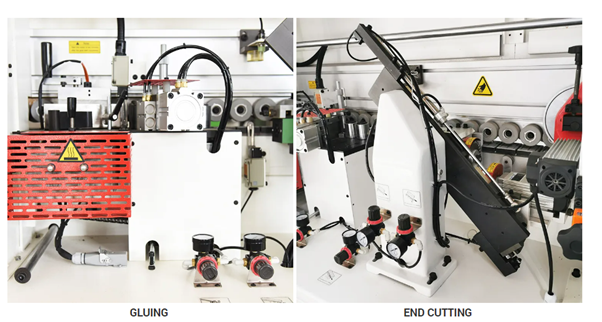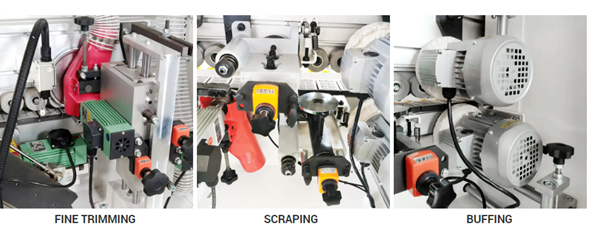Technical Specifications
| Items | Specifications |
|---|---|
| Panel length | Min 120 |
| Panel width | Min 0.80 |
| Panel thickness | 10-50 mm |
| Edge thickness | 0.4-3 mm |
| Working pressure | 0.6 Mpa |
| Feeding speed | 13 m/min |
| N.W | 650 kg |
| Overall size | 3155*1110*1300 mm |
| Items | Specifications |
|---|---|
| Panel length | Min 120 |
| Panel width | Min 0.80 |
| Panel thickness | 10-50 mm |
| Edge thickness | 0.4-3 mm |
| Working pressure | 0.6 Mpa |
| Feeding speed | 13 m/min |
| N.W | 650 kg |
| Overall size | 3155*1110*1300 mm |
PVC EDGE BANDING MACHINE
Edge banding machine is used to cover the exposed sides of materials such as
plywood, particle board or MDF, giving the appearance of a solid (or more valuable)
material. Can also be used instead of features such as face frames or moulding.
An edge bander is a machine used to create decorative edges on panels and boards
automatically. The machine cuts the wood's edge and then uses adhesive to attach
colourful edge strips or other materials.
Edge banding or edge banding is the name of both a process and an associated
narrow strip of material used to create durable and aesthetically pleasing trim edges
during finish carpentry.
Edge banding is used to cover the exposed sides of materials such as plywood,
particle board or MDF, increasing durability and giving the appearance of a solid or
more valuable material. Common substitutes for edge banding include face frames
or moulding. Edge banding can be made of different materials including PVC, ABS,
acrylic, melamine, wood, or wood veneer.
Traditional edge banding was a manual process requiring ordinary carpentry tools
and materials. In modern applications, particularly for high-volume, repetitive
manufacturing steps such as cabinet doors, edge banding is applied to the substrate
by an automated process using a hot-melt adhesive. Hot melt adhesives may consist
of various raw materials including EVA, PUR, PA, APOA, and PO. A substrate
primer may also be used as a bonding agent between the adhesive and the
substrate. Thicker edge bandings typically require a slight concavity to provide a tight
glue line. The thickness can vary from .4" to 3mm or even more. The machine that
applies the edge banding is called edge bander. An edge bander bonds the edge
banding to the substrate, trims the leading and trailing edges, trims top and bottom
flush with the substrate, scraps any surplus, and buffs the finished edge.
Thermoplastic edge banding is produced with an extruder, a machine that consists of
a loading system for raw materials, a screw inside a barrel that melts and transports
the raw materials (plastics PVC, ABS, PP, PMMA and colour pigments) through a
die which shapes the edge banding into the required size. After the Edge banding is
extruded, it can be texturized, printed, and lacquered to provide the required finish.
The edge banding is then rolled and send to customers.

